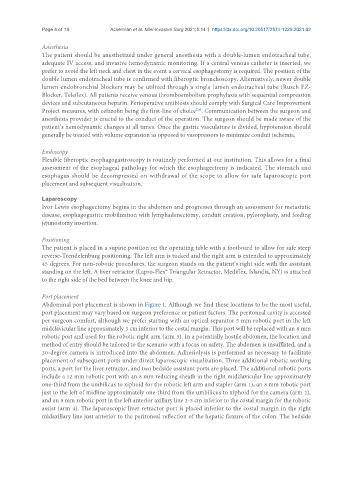Page 133 - Read Online
P. 133
Page 4 of 19 Ackerman et al. Mini-invasive Surg 2021;5:14 https://dx.doi.org/10.20517/2574-1225.2021.02
Anesthesia
The patient should be anesthetized under general anesthesia with a double-lumen endotracheal tube,
adequate IV access, and invasive hemodynamic monitoring. If a central venous catheter is inserted, we
prefer to avoid the left neck and chest in the event a cervical esophagostomy is required. The position of the
double lumen endotracheal tube is confirmed with fiberoptic bronchoscopy. Alternatively, newer double
lumen endobronchial blockers may be utilized through a single lumen endotracheal tube (Rusch EZ-
Blocker, Teleflex). All patients receive venous thromboembolism prophylaxis with sequential compression
devices and subcutaneous heparin. Perioperative antibiosis should comply with Surgical Care Improvement
Project measures, with cefazolin being the first-line of choice . Communication between the surgeon and
[26]
anesthesia provider is crucial to the conduct of the operation. The surgeon should be made aware of the
patient’s hemodynamic changes at all times. Once the gastric vasculature is divided, hypotension should
generally be treated with volume expansion as opposed to vasopressors to minimize conduit ischemia.
Endoscopy
Flexible fiberoptic esophagogastroscopy is routinely performed at our institution. This allows for a final
assessment of the esophageal pathology for which the esophagectomy is indicated. The stomach and
esophagus should be decompressed on withdrawal of the scope to allow for safe laparoscopic port
placement and subsequent visualization.
Laparoscopy
Ivor Lewis esophagectomy begins in the abdomen and progresses through an assessment for metastatic
disease, esophagogastric mobilization with lymphadenectomy, conduit creation, pyloroplasty, and feeding
jejunostomy insertion.
Positioning
The patient is placed in a supine position on the operating table with a footboard to allow for safe steep
reverse-Trendelenburg positioning. The left arm is tucked and the right arm is extended to approximately
45 degrees. For non-robotic procedures, the surgeon stands on the patient’s right side with the assistant
standing on the left. A liver retractor (Lapro-Flex® Triangular Retractor, Mediflex, Islandia, NY) is attached
to the right side of the bed between the knee and hip.
Port placement
Abdominal port placement is shown in Figure 1. Although we find these locations to be the most useful,
port placement may vary based on surgeon preference or patient factors. The peritoneal cavity is accessed
per surgeon comfort, although we prefer starting with an optical separator 5 mm robotic port in the left
midclavicular line approximately 3 cm inferior to the costal margin. This port will be replaced with an 8 mm
robotic port and used for the robotic right arm (arm 3). In a potentially hostile abdomen, the location and
method of entry should be tailored to the scenario with a focus on safety. The abdomen is insufflated, and a
30-degree camera is introduced into the abdomen. Adhesiolysis is performed as necessary to facilitate
placement of subsequent ports under direct laparoscopic visualization. Three additional robotic working
ports, a port for the liver retractor, and two bedside assistant ports are placed. The additional robotic ports
include a 12 mm robotic port with an 8 mm reducing sheath in the right midclavicular line approximately
one-third from the umbilicus to xiphoid for the robotic left arm and stapler (arm 1), an 8 mm robotic port
just to the left of midline approximately one-third from the umbilicus to xiphoid for the camera (arm 2),
and an 8 mm robotic port in the left anterior axillary line 2-3 cm inferior to the costal margin for the robotic
assist (arm 4). The laparoscopic liver retractor port is placed inferior to the costal margin in the right
midaxillary line just anterior to the peritoneal reflection of the hepatic flexure of the colon. The bedside

